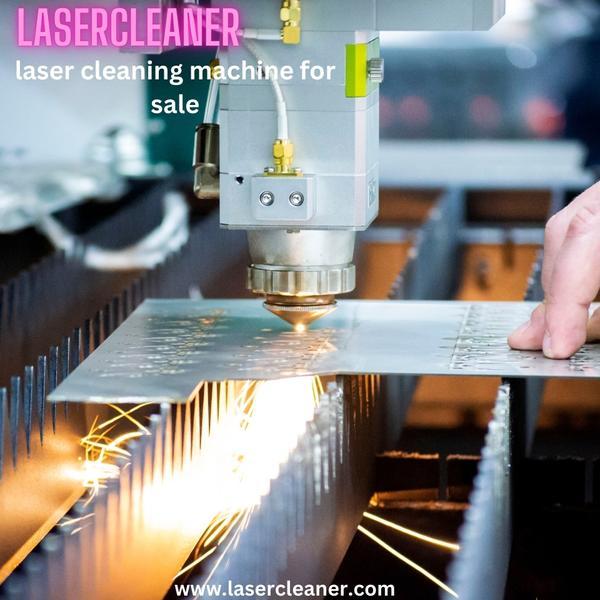What is a Laser Cleaning Machine?
A laser cleaning machine for sale is an innovative industrial tool designed to remove rust, paint, oxide, grease, and other contaminants from metal or non-metal surfaces using laser beam technology. It provides a non-contact, eco-friendly, and highly precise method of surface cleaning. This method is becoming increasingly popular across manufacturing, aerospace, automotive, heritage restoration, and oil & gas sectors.
Why Choose a Laser Cleaning Machine Over Traditional Methods?
Here’s how laser cleaning compares to conventional methods like sandblasting, chemical cleaning, and manual scraping:
| Feature | Laser Cleaning | Sandblasting | Chemical Cleaning | Manual Scraping |
|---|---|---|---|---|
| Contact-Free | Yes | No | No | No |
| Surface Damage Risk | Minimal | High | Medium | High |
| Consumables Required | No | Yes (sand/grit) | Yes (chemicals) | No |
| Operator Safety | High | Moderate | Low | Moderate |
| Environmental Impact | Low | High (dust) | High (toxicity) | Low |
| Precision | Excellent | Low | Medium | Low |
Key Benefits of Using a Laser Cleaning Machine
-
Eco-Friendly Operation – No solvents, abrasives, or chemicals involved.
-
Highly Selective – Removes unwanted layers without affecting the base material.
-
Low Maintenance – Long operational life with minimal consumables.
-
Automation-Ready – Easily integrated with robotic arms and CNC systems.
-
Safe and Easy to Use – Minimal training required with smart safety protocols.
Who Needs a Laser Cleaning Machine?
Laser cleaners are ideal for:
-
Manufacturing Plants – For mold cleaning, weld preparation, or surface coating removal.
-
Aerospace Industry – For precision degreasing or coating removal without damaging sensitive components.
-
Automotive Sector – To remove paint, rust, and prep surfaces for welding or repainting.
-
Conservation Projects – Restoring artifacts or monuments with minimal abrasion.
-
Marine & Oil Industries – For rust removal on pipelines, ship hulls, and machinery.
How Does a Laser Cleaning Machine Work?
The machine emits pulsed laser beams that hit the contaminated surface. The energy causes a thermal reaction—vaporizing, fragmenting, or lifting off the unwanted material layer-by-layer without any physical contact.
-
Step 1: The laser beam is directed at the surface.
-
Step 2: Contaminants absorb the laser energy and disintegrate.
-
Step 3: Clean, unaltered surface remains.
-
Step 4: Optional fume extraction removes any by-products for a cleaner process.
Types of Laser Cleaners Available
| Type | Best For | Laser Power Range |
|---|---|---|
| Handheld Laser | On-site, portable cleaning | 50W – 2000W |
| Stationary Laser | Production lines, automated use | 500W – 3000W |
| Pulse Fiber Laser | Precision cleaning, minimal heat | 100W – 1000W |
| Continuous Fiber | Heavy-duty, large surface cleaning | 1000W – 3000W |
What to Look for When Buying a Laser Cleaning Machine for Sale
-
Laser Power: Higher power allows deeper and faster cleaning.
-
Cooling System: Look for efficient water-cooled or air-cooled systems.
-
Beam Delivery: Check if it’s flexible for manual and robotic operation.
-
Control Interface: Smart touchscreen or remote control adds convenience.
-
Safety Certification: Ensure the machine complies with international safety standards.
Real-World Use Cases
Automotive Workshop: Cut cleaning time for rusted parts by 70% using a 1000W laser unit.
Aircraft Maintenance: Extend part life by removing coatings without abrasive wear.
Shipyard: A 2000W continuous laser system restored corroded areas 4x faster than traditional grinding.
Frequently Asked Questions (FAQs)
Q1: Is laser cleaning safe for delicate surfaces?
Yes, pulse fiber lasers offer high precision, making them ideal for sensitive applications such as historical artifacts or fine electronics.
Q2: Can the machine be used outdoors?
Portable, handheld laser cleaners are perfect for outdoor environments, provided proper ventilation and safety measures are observed.
Q3: What is the expected lifespan of a laser cleaning system?
With proper care, a laser cleaner can operate reliably for over 100,000 hours.
Q4: Are there recurring maintenance costs?
Minimal. No consumables are required, and fiber lasers typically have low service needs.
Q5: Do laser cleaning machines produce harmful fumes?
Fume extraction systems are typically included to handle any residue or smoke, making the process clean and operator-safe.
Final Thought
A laser cleaning machine for sale is more than a surface prep tool—it’s a strategic investment in productivity, safety, and quality. As industries move toward greener, faster, and more reliable cleaning solutions, the demand for these machines continues to rise. If you're exploring efficient ways to enhance your operations, evaluating the right laser cleaner model could redefine your workflow.

